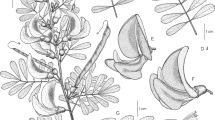Summary
The tree species Berlinia korupensis Mackinder & Burgt is described as new. The species is endemic to the southern part of Korup National Park in Cameroon. Seventeen trees have been found so far, the largest being 42 m high and having a trunk diam. of 88 cm. The new species is assessed as Critically Endangered (CR D) under the criteria of IUCN. Two distribution maps are included; one map indicating the single locality in Cameroon near the Nigerian border where the new species was found and another map of the permanent plot where 14 of the 17 trees were recorded. A line drawing is also included, along with colour photographs of the flowers and the trunk.




Similar content being viewed by others
Notes
The functionality of these flowers is hypothesised here as the viability of the pollen is not known.
References
Aubréville, A. (1968). Les Césalpinioidées de la Flore camerouno-congolaise. Adansonia, ser. 2, 8: 147 – 175.
Burgt, X. M. van der (1997). Explosive seed dispersal of the rainforest tree Tetraberlinia moreliana (Leguminosae – Caesalpinioideae) in Gabon. J. Trop. Ecol. 13: 145 – 151.
IUCN (2001). IUCN Red List Categories and Criteria: version 3.1. IUCN, Gland, Switzerland & Cambridge, UK.
Kenfack, D., Thomas, D. W., Chuyong, G. B. & Condit, R. (2006). Rarity and abundance in a diverse African forest. Biodivers. & Conservation 15: 4097 – 4117.
Letouzey, R. (1968). Étude phytogéographique du Cameroun. Lechevalier Paris.
Newbery, D. M., Songwe, N. C. & Chuyong, G. B. (1998). Phenology and dynamics of an African rainforest at Korup, Cameroon. In: D. M. Newbery, H. H. T. Prins & N. D. Brown (eds), Dynamics of tropical communities, pp. 267 – 308. Blackwell, Oxford.
Wieringa, J. J. (1999). Monopetalanthus exit. A systematic study of Aphanocalyx, Bikinia, Icuria, Michelsonia and Tetraberlinia. Wageningen Agr. Univ. Pap. 99: 1 – 320.
Acknowledgements
The authors would like to thank Prof. David Newbery of the Institute of Plant Sciences, University of Bern, who supervised the ecological research that lead to the discovery of the present new species. The field research was funded by the Swiss National Science Foundation (Grant 3100-066655 to Prof. Newbery), and coordinated by Dr G. Chuyong. Three funds of the Royal Botanic Gardens, Kew, the Donations fund, the OFC fund and the Bentham-Moxon fund, also funded the collection of specimens and data. We thank the Cameroon government for permission to carry out research in Cameroon, and Korup National Park (Conservator, A. Kembou) for access to the site. We also thank the National Herbarium of Cameroon (Head, J.-M. Onana) for cooperation. Moses Elangwe climbed the tree from which the holotype was collected. Wolfgang Bischoff, Motoh Jackson, Sylvanos Njibili and Charles Okha provided field assistance. We would also like to thank Margaret Tebbs for preparing the illustration and Melanie Thomas for translating the Latin diagnosis.
Author information
Authors and Affiliations
Corresponding author
Rights and permissions
About this article
Cite this article
Mackinder, B.A., van der Burgt, X.M. Berlinia korupensis (Leguminosae – Caesalpinioideae), a new tree species from Cameroon. Kew Bull 64, 129–134 (2009). https://doi.org/10.1007/s12225-009-9100-z
Received:
Revised:
Accepted:
Published:
Issue Date:
DOI: https://doi.org/10.1007/s12225-009-9100-z




